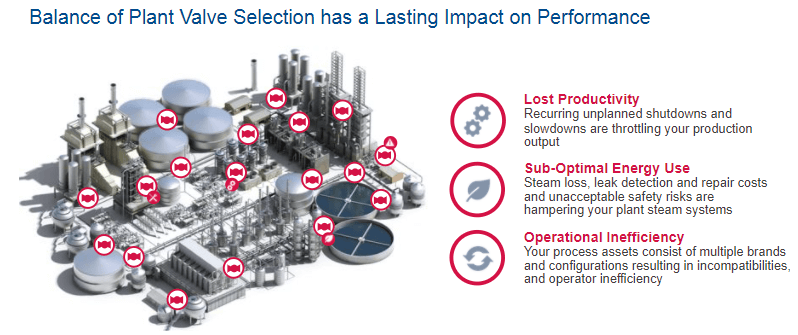At the Emerson Exchange Americas virtual sessions, Emerson’s David van Veen shared ways to improve operational performance with balance of plant valve optimization. Here is his presentation abstract:
This session offers an overview of the utility systems that are critical for best plant performance. We will review the source and effects of abrasion and corrosion issues related to your Isolation Valves and what can be done to address this common problem. We will highlight the safety aspects related to isolation certainty in steam service as well as the cost benefit
tied to supporting your LDAR program. Finally, we will address overall valve and actuation performance and how quality standardization in common systems will offer longevity, drive safe product choice and reduce overall yearly expenditures.
David open describing some of the impacts of poor balance of plant valve performance.
Valve with strong performance deliver increased process uptime, reduced steam loss and energy costs, and improved operational efficiency. Valves can be subject to environmental conditions, chemical attack, debris and corrosion. Process uptime is increased through proper valve seat design, build quality, material selection for its intended use, and regulatory compliance to design standards and industry regulations.
From an energy efficiency and safety standpoint, valves accounts for 60% of fugitive emissions and these emissions lead to higher energy costs, increased risk to plant personnel and increased maintenance costs. Outdated linear valves can be replaced with quarter turn valve designs with technologies such as triple-offset seating which deliver zero leakage.
From an operational efficiency standpoint, modern valve automation can help avoid integration complexity, added costs, and performance risks. Proper process isolation improves plant safety, single supplier configuration of the valve and actuator enables high performance and comprehensive support. Valve automation reduces manual valve operation freeing plant personnel for higher value activities.
For new projects, David recommended specifying balance of plant valves that will deliver reliability for your specific process conditions and plant environment. Match the right valve technology with the right applications to standardize and optimize your CAPEX and OPEX spends. Enlist in an expert valve partner to help specify select automate install and commission
complete valve solutions.
For existing operations, identify recurring valve failures and consult with expert valve partners to solve with better-suited technology to drive uptime improvements. Benchmark balance of plant systems to identify underperformance and address these to improve overall plant performance and profitability. Review operational efficiency and look for opportunities where
automation investment can improve returns.
Visit the Valves, Actuators & Regulators section on Emerson.com for more on the breadth of final control products, project management, connected services, and service networks to help you achieve Top Quartile performance.


